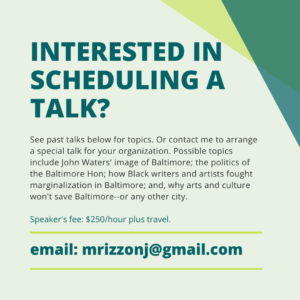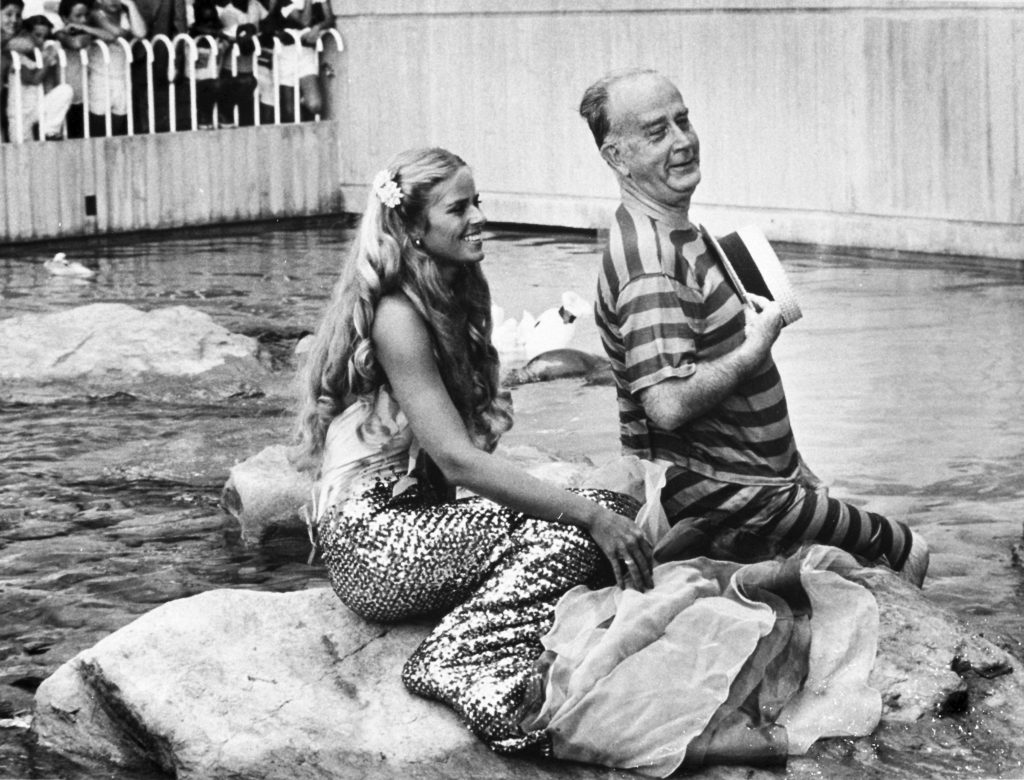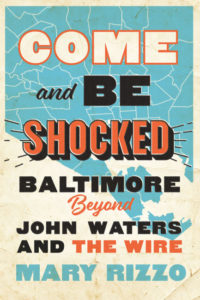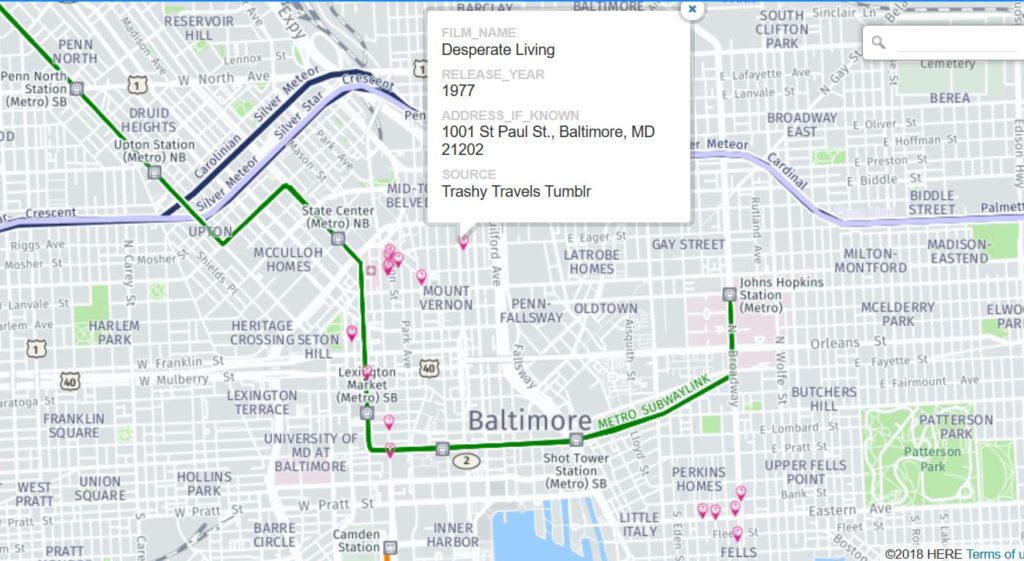Come and Be Shocked: Baltimore Beyond John Waters and The Wire
Charm City or Bodymore?
In Come and Be Shocked, Mary Rizzo examines the cultural history and racial politics of these contrasting images of Baltimore. From the 1950s, a period of urban crisis and urban renewal, to the early 21st century, Rizzo looks at how artists created powerful images of Baltimore. How, Rizzo asks, do the imaginary cities created by artists affect the real cities that we live in? How does public policy (intentionally or not) shape the kinds of cultural representations that artists create? And why has the relationship between artists and Baltimore city officials been so fraught, resulting in public battles over film permits and censorship?
Praise for Come and Be Shocked
“Come and Be Shocked is well written, deeply researched, and a pleasure to read.” — Matthew Delmont, author of Half American: The Epic Story of African Americans Fighting WWII at Home and Abroad
“Come and Be Shocked is a tremendous achievement–a true pace-setter for how studies of urban culture and representation ought to be done. Surveying a startling diversity of cultural texts and genres, Rizzo conjures up brilliant insights on how Baltimore narratives and iconography both reflected and intervened in the social processes reshaping the city’s postwar fabric.” — Benjamin Looker, author of A Nation of Neighborhoods: Imagining Cities, Communities, and Democracy in Postwar America
“Tackling a fascinating topic, Come and Be Shocked raises important points about the cultural lives of cities that I had not thought much about. A clear, insightful, and important book. Mary Rizzo’s writing is punchy and crisp.” — Emily Lieb, Seattle University
“An ambitious, original, and engaging book. Full of fascinating material, Come and Be Shocked breaks new ground in the study of Baltimore and of the economics and politics of culture.” — Randy J. Ontiveros, University of Maryland
“As Rizzo weaves together narratives of a city long divided by race, she, too, helps to paint a picture of what Baltimore’s identity was, what it is, and what it’s becoming.’ — Lauren LaRocca, Baltimore Magazine
“Rizzo’s book implies that if we, as scholars and humans, can begin to read the divergent parts of the city together we might imagine what a more equitable city might look and sound like.” — Nicole King, The Public Historian
Events
Upcoming Events
Black Arts Baltimore: A Counter History of the 1960s and 1970s
September, 6, 2022
7:00pm
Online or in-person at Enoch Pratt Free Library, Baltimore
In histories of Baltimore, the arts rarely occupy center stage. But during the 1960s and 1970s, Black artist-activists in Baltimore used culture to push for liberation. In this talk, Mary Rizzo will discuss her current research on this little-examined aspect of Baltimore Black history and how it changes our dominant narratives of Charm City.

Past Events
Culture for Cities? A Conversation about the Role of Arts in Baltimore and Newark
Are the arts good for cities? Are city policies good for artists?
Using Baltimore and Newark as case studies, this virtual event will
examine how the role of the arts in cities has changed since the 1970s.
What happens when the arts become part of redevelopment efforts? Who
wins and who loses?
This event, which draws from Mary Rizzo’s recent book ExternalCome and Be Shocked: Baltimore Beyond John Waters and The Wire,
will feature a brief talk by Rizzo and a panel discussion with artists
and scholars from Baltimore and Newark on the vexed relationship between cities and the arts.
Missed the event? Watch here.
Come and Be Shocked!: Baltimore Beyond John Waters and The Wire
Hamilton Street Club, July 27, 2021
Osher Lifelong Learning Center, Johns Hopkins University, July 23, 2021
Is Baltimore Charm City or Bodymore? In this talk, cultural historian Mary Rizzo will reveal the battles between filmmakers, writers, and other artists and city officials over Baltimore’s image. From the 1974 Charm City ad campaign to contemporary fights over the Baltimore Hon as a local icon, this talk will show why managing its image has become a central part of municipal efforts and why that matters.
Mermaids & Promenades: Schaefer and the Cultural Redevelopment of Baltimore
Baltimore Architectural Forum
March 19, 2021, 1pm
In the 1970s, Mayor William Donald Schaefer used arts and culture to sell a new image of Baltimore as quirky and charming to both tourists and business leaders. In this talk, Mary Rizzo will examine forgotten moments from Schaefer’s terms as mayor, from the creation of a failed local version of the Oscars, called “The Don” awards to honor Baltimore’s film business, to the Baltimore Promenade, a public art project designed to integrate city neighborhoods through the act of walking.
To watch a recording of this talk, click here.
“’Black Poetry Does’: Chicory Magazine, Black Counternarratives, and Making Poetry Public History”
Urban History Speaker Series, Temple University
February 26, 2021, 2pm
Chicory magazine represented a counternarrative to the urban crisis as it was understood in Baltimore from the 1960s-1980s. In this talk, Mary Rizzo explores Chicory’s role in the community and discusses her efforts to bring the magazine back to life in Baltimore.
February 17, 2021
Whose Cities?: Cultural Studies Approaches to (Sub)urban Studies and Race
with Kyle Riismandel
Join Professors Mary Rizzo and Kyle Riismandel for a live conversation about cultural approaches to urban/suburban studies and race on Wednesday, February 17 at 2:30pm. Watch on Youtube.
October 5, 2020
Mermaids and Promenades: William Donald Schaefer and the Cultural Redevelopment of Baltimore
Baltimore City Historical Society
In the 1970s, Mayor William Donald Schaefer used arts and culture to sell a new image of Baltimore as quirky and charming to both tourists and business leaders. In this talk, Mary Rizzo will examine forgotten moments from Schaefer’s terms as mayor, from the creation of a failed local version of the Oscars, called “The Don” awards to honor Baltimore’s film business, to the Baltimore Promenade, a public art project designed to integrate city neighborhoods through the act of walking. While Schaefer is remembered for large-scale projects like Harborplace and stunts like posing with a mermaid for the opening of the Baltimore aquarium, his legacy should include his reimagining city government to include arts and culture–for good and ill.
To watch a recording of this talk, click here.
September 22, 2020
Writers LIVE! Mary Rizzo, Come and Be Shocked: Baltimore beyond John Waters and The Wire
Enoch Pratt Free Library
Mary Rizzo in conversation with Wesley Wilson and Melvin Brown about Chicory magazine, a poetry magazine published from 1966-1983 as the voice of Baltimore’s black community. The event is hosted by the Enoch Pratt Free Library and startd at 7pm.
To listen to a podcast of this event, click here. To see a video of this event, click here.

Media
“Come and Be Shocked,” (review) Journal of American History, April 2022.
The Best Books to Understand Why Baltimore’s problems are so Hard to Fix,” Shepherd, October 2021.
“Book Review: Come and Be Shocked,” The Crab: The Digital Magazine of the Maryland Library Association, Spring 2021.
“Come and Be Shocked,” (review) The Public Historian, May 2021.
“Cities and Suburbs in the Pandemic,” Covid Calls podcast, March 15, 2021.
“On Baltimore: Narratives and City Making,” (review) Public Books, February 5, 2021.
“Hey Hon: Let a curious visitor tell you why Baltimore is so special from the outside,” Baltimore Positive podcast, November 22, 2020.
“Baltimore’s Shifting Cultural Terrain–A Review of Come and Be Shocked,” The Metropole, September 29, 2020.
“Mary Rizzo’s New Book on Baltimore Invites Readers to “Come and Be Shocked,“” Rutgers SASN, September 22, 2020.
“Come and Be Shocked: Examining Baltimore’s Identity through the Lens of Media,” Midday With Tom Hall, WYPR, September 18, 2020.
“The Wire and Other Baltimore Shows are Great TV, But There are Reasons to Be Wary,” LitHub, September 16, 2020.
Page 99 of Come and Be Shocked, Campaign for the American Reader, September 18, 2020.
“Happy birthday, Harborplace. Now what?” Baltimore Sun, July 9, 2020.
Review of Come and Be Shocked, Baltimore Magazine, May 2020.
“Author Mary Rizzo examines the arts’ role in Baltimore’s identity,” Baltimore Magazine, May 2020.
“Baltimore needs more than ’empty boosterism,'” Baltimore Sun, August 2, 2019.
To arrange a talk at your institution, contact Mary Rizzo at mrizzonj@gmail.com.
Where did John Waters Film His Early Movies?
From the late 1960s to the mid-1970s, John Waters and his merry band of artistic outcasts shot films all over downtown Baltimore. Using books by Waters and his pals and fan sites, I mapped as many locations as possible. Click on the map above for an interactive version.

